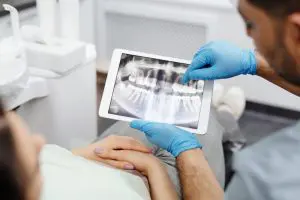Depending on your age, you might have observed that scanning your teeth for cavities is far more advanced today than when you were a kid. Well, at least it should be. There have been so many advancements in dental imaging, and we keep up with the latest and greatest dental X-rays to ensure patient protection and accuracy. We use digital dental X-rays to improve the process for you and us.

(Cedric Fauntleroy/Pexels)
How does digital dental radiology work?
Technically speaking, the process of digital X-raying is similar to the traditional method. Like the traditional way, a dental professional inserts a sensor into your mouth, which aids in capturing images of your teeth. The difference is the sensor used in digital radiology is an electronic device connected to a computer. The device captures the images and then projects them on screen in real time so you can view the same picture as your dentist.
Digital X-rays aid in treating tooth and gum diseases quickly, painlessly, and efficiently. Here are nine incredible benefits and facts about dental imaging:
1. Less Radiation
New and improved digital X-rays use over 70% less radiation than the traditional method. That is a huge difference and something anyone would get on board with. Less radiation means fewer potential side effects and reduced long-term X-ray exposure risk. This alone is a big win in dental imaging and provides a safer way to administer X-rays of the mouth.
2. Higher Quality Images
Since digital X-rays use digital sensors instead of traditional X-ray film, the quality is much higher, and the pictures are saved right onto the computer. Higher resolution means diagnosing and catching potential issues in the teeth, gums, or other oral structures is easier. Higher-quality images make for more accurate results.
3. Quicker Appointments
Gone are the days of waiting and waiting while your dental hygienist took forever to prepare the film and all the equipment and then waited to view it. There is no preparation time involved with digital X-rays. This means faster appointments, immediate viewing, and less time sitting around at your dentist appointment. Anyone can get on board with that.
4. Easier to Transfer
Dentists can now send digital images straight to other dental or medical specialists, such as oral surgeons and orthodontists, with the click of a button. No more waiting for a referred specialist to receive your records. This also lessens the chance of lost X-rays. Sending X-rays digitally is faster, more organized, and more secure.
5. Enlargement Capabilities
With traditional X-rays, the dentist can only view an image at its actual size. In contrast, with digital X-rays, you can enlarge the photos, enabling dental professionals to zoom in on specific problem areas and get a better look.
6. Electronic Storage
This is primarily a perk for dental offices because they no longer have stacks of paperwork and files everywhere. Still, it’s also a perk for patients because dental offices can securely keep these images on the cloud forever for future reference.
7. Easier to Access
Digital dental images can be printed, emailed, and shared quickly. This makes it easy to send secure copies to insurance companies which helps to speed up the process for insurance claims.
8. Better for the Environment
As a family dentistry in Utah, we do what we can to reduce our carbon footprint. Digital X-rays don’t require processing chemicals like traditional ones, which is exponentially better for the environment—no more hazardous waste or pollution.
9. Money Saver
Digital X-rays save time and money due to earlier detection. Digital X-rays help to minimize treatments or detect problems early enough to treat them.
Special Training
Dental professionals who take digital X-rays all completed special training. The training requirements may differ depending on the area but, rest assured, all dentists in Utah must meet a set of requirements before taking your digital X-ray. You can find the digital X-ray requirements in state dental practice acts or dental board regulations. Training regulations include:
- Periodic safety updates and specialized training in new equipment, supplies, and techniques.
- Infection control procedures.
- Continuing education in the safe use of radiation equipment.
In the 1800s, film X-rays were a revolutionary invention that paved the way for dentistry. Technological advances have come a long way since the first inventions, and traditional dental imaging is almost obsolete. However, some dentists haven’t kept up with these advances and stick to the traditional methods. When searching for a Utah family dentist, ask what type of technology they use for X-rays. If they haven’t updated this practice, they may still use other outdated methods as well. It’s important to keep up with the latest advancements in any industry. Your dentist should prioritize the well-being of their patients and do everything they can to make the experience more enjoyable and more efficient.
